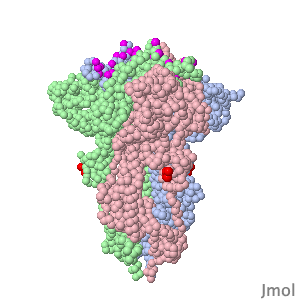Proteopedia:Featured SEL/5
From Proteopedia
(Difference between revisions)
| (10 intermediate revisions not shown.) | |||
| Line 2: | Line 2: | ||
<tr><td> | <tr><td> | ||
<imagemap> | <imagemap> | ||
| - | Image: | + | Image:Spike-protein-priming.gif|center |
default [[SARS-CoV-2 protein S priming by furin]] | default [[SARS-CoV-2 protein S priming by furin]] | ||
</imagemap> | </imagemap> | ||
</td></tr> | </td></tr> | ||
| - | <tr><td><div class='scrolling '>''' | + | <tr><td><div class='scrolling '>'''Coronavirus Spike Protein Priming'''<br> |
''by Eric Martz''<br> | ''by Eric Martz''<br> | ||
| - | + | Coronavirus SARS-CoV-2 (responsible for COVID-19) has a spike protein on its surface, which enables it to infect host cells. Initially, proteases in the lungs clip the homo-trimeric spike protein at a <font color="#e00000">'''unique sequence'''</font>. This primes it, causing it to extend its <font color="#e000e0">'''receptor binding surface'''</font> (shown in the above animation), optimizing binding to the host cell's ACE2 receptor (not shown). Next, spike protein initiates fusion of the virus and host cell membranes (not shown), enabling the virus RNA to enter the cell and initiate production of new virions. Knowledge of spike protein's molecular structure and function is crucial to developing effective therapies and vaccines. | |
| - | + | <br>>>> [[SARS-CoV-2_protein_S_priming_by_furin|Visit this page]] >>> | |
| - | >>> [[SARS-CoV-2_protein_S_priming_by_furin|Visit this page]] >>> | + | |
</div> | </div> | ||
</td></tr> | </td></tr> | ||
Current revision
Coronavirus Spike Protein Priming
by Eric Martz |


